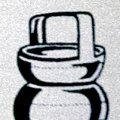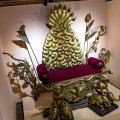Patan Museum (Nepal): photo 149
Photo 149 of 212 in Gallery: Patan Museum (Nepal)

Image title: The God Ganesha
Description of the photo
Known to Nepalis as “Ganesh” (Ganesha) and sometimes “Binayak” (Vinayaka), the elephant-headed son of Shiva and Paryati is one of the. most popular deities in Nepal. He is beloved (and feared) by both Hindus and Buddhists. As the maker and—if he wishes—remover of obstacles his worship precedes any important undertaking: a wedding, business venture, trip, and even prayers to other gods.
Ganesha is everywhere and has numerous images. Standing or sitting, he is most commonly depicted with four arms, a huge belly, and dipping his trunk in a bowl of ball-like sweets (laddu, modaka). They symbolize supreme wisdom. Sometimes Ganesa is shown dancing and is occasionally paired with a spouse of much smaller size. He may have multiple heads and limbs and has both wrathful and benign aspects. His names are many but few are employed in Nepal. Curiously, the vehicle of this elephantine deity is among the smallest of creatures, a mouse, rat or shrew.
Ganesha often holds a radish, an alternate for the broken tusk he once hurled at the mocking moon. This emblem, once thought to be unique to the Nepalese Ganesha, is now known to have been used for Indian Ganesha images since at least the 6th century A.D.
Many legends explain Ganesha’s singular appearance, the objects he holds, and his dress and ornaments. His elephant head—so say some—came about in the following way. Posted as Parvati’s gatekeeper, sworn to let no one enter, Ganesha even denied Shiva entrance. Enraged, Shiva beheaded the boy. The distraught Parvati demanded that the life and head of their son be restored. Shiva agreed to replace the severed head with that of the next being to appear. It was an elephant.
Gallery information:
The Patan Museum is located on the Durbar square of Patan (Lalitpur/Lalitapura, Kathmandu, Nepal) which is associated Keshav Narayan Chowk (Keshavnarayan)—a form of Lord Vishnu. Being listed as a World Heritage Site, the whole of Durbar square is filled with exquisite temples, sculptures and other ancient structures, of which the ancient history history can be traced to the Malla Kings of Lalitpur. It is an important site for both Buddhism and Hinduism.
Photo details:
Date: 2019-12-02
Camera: SONY ILCE-6400
Exposure: 1/60
Aperture: f/4
ISO: 200
Focal length: 18mm
High resolution:
Download file
Size: 2.70 MB
Resolution: 2000 x 2529
© Photograph by Gabe Hiemstra.
License: CC BY-NC-ND 4.0

